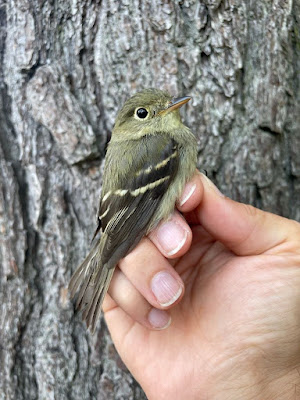CAPTAIN SAMS
Today things remained fairly consistent at Captain Sams, but numbers are still low. We captured 29 new birds and recaptured 11 for a total of 40. Hopefully tomorrow the trend of slower days will change. As winds are beginning to shift migratory conditions look favorable for tomorrow and the rest of this week (as long as nothing in the forecast changes). We expect another large push of Common Yellowthroats this week. We are expecting one more large push of Yellowthroats before their numbers will start to taper off and be replaced by Gray Catbirds. We are also holding out for more neotropical migrant numbers to increase, like Black-throated Blue Warblers, and are also expecting Palm Warbler numbers to start to pick up.
-Noah Nei
LITTLE BEAR
Today was a little bit of a busier day. We ended our day with a total of 52 birds, 38 newly banded birds and 14 recaptures. A new species for little bear was added today for the season, a Least Flycatcher. I was holding out on catching one soon and today was our day. We had a little push of Common Yellowthroats today and I am thinking our next big push will be our Gray Catbirds. I am ready to hear the calls of the marsh cats out at Little Bear. I am hoping tomorrow will pick up a little bit and get everyone ready for that first fun push of birds
-Kristin
| Species | Captain Sams | Little Bear | ||
|---|---|---|---|---|
| New | Recaps | New | Recaps | |
Least Flycatcher | - | - | 1 | - |
White-eyed Vireo | - | 2 | 1 | - |
Red-eyed Vireo | 2 | - | - | - |
Carolina Chickadee | - | - | - | 1 |
Carolina Wren | - | 1 | - | - |
Gray Catbird | 1 | - | - | - |
Brown Thrasher | - | 1 | - | - |
Veery | - | - | 1 | - |
Eastern Towhee | - | - | - | 1 |
Common Yellowthroat | 17 | 3 | 22 | 1 |
American Redstart | - | - | 1 | - |
Northern Parula | - | 1 | - | - |
Yellow Warbler | 1 | - | 1 | - |
Black-throated Blue Warbler | - | 1 | - | - |
Palm Warbler (western) | 6 | - | 2 | - |
Prairie Warbler | 1 | 1 | - | - |
Northern Cardinal | - | - | - | - |
Painted Bunting | 1 | 1 | 8 | 11 |
| Today's Banding Stats | Captain Sams | Little Bear | TOTAL |
|---|---|---|---|
| # Birds Banded | 29 | 38 | 67 |
| # of Recaptures | 11 | 14 | 25 |
| # of Species | 12 | 11 | 18 |
| Effort (net-hours) | 166.4 | 100 | 266.4 |
| Capture Rate (birds/100 net-hours) | 24.0 | 52 | 34.5 |
| # of Nets | 32 | 25 | 57 |
| 2024 Fall Cumulative Banding Stats | Captain Sams | Little Bear | TOTAL |
|---|---|---|---|
| # Birds Banded | 1,919 | 1,264 | 3,183 |
| # of Recaptures | 516 | 372 | 888 |
| # of Species | 55 | 54 | 68 |
| Effort (net-hours) | 7,154.1 | 4,113.1 | 11,267.2 |
| Capture Rate (birds/100 net-hours) | 34.0 | 39.8 | 36.1 |
| # of Days | 45 | 37 |
Banding Staff
Aaron Given (CS)






